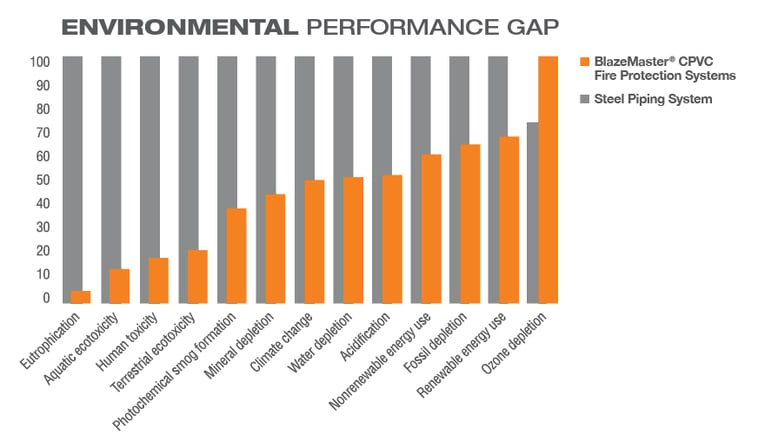Misconceptions About CPVC and How to Combat Them
CPVC fire protection systems are saving the lives of countless people and firefighters, and preventing property damage every day. BlazeMaster® CPVC – the world’s first CPVC fire protection system, introduced in 1984 – is used throughout the world today.
To some, however, CPVC is still a mystery. How can a thermoplastic material perform as well as steel? Won’t it melt when exposed to high heat? By simply doing the job it was intended to do – quenching a fire before the fire was able to spread.
That’s why it’s puzzling that CPVC fire sprinkler systems remain a mystery, or even suspect, to some in the fire protection industry. After more than 30 years, misconceptions still abound.
Here are five of the most common misconceptions about CPVC. I address each one in an effort to help you put them to rest in the event you are questioned when discussing or quoting an upcoming fire sprinkler project.
Misconception #1: CPVC Will Melt in a Fire
Absolutely not. BlazeMaster CPVC’s unique formulation means that it performs as designed when the heat is on, ensuring that the fire sprinkler system can work to suppress a fire.
Exposed to flash ignition temperatures, CPVC chars or intumesces and does not drip or spread a fire. The char layer acts as a thermal barrier to restrict the flow of heat into the pipe wall. This slows the rate of burning and allows more time for occupants to evacuate and first responders to arrive. Once a sprinkler head activates, the water flow dissipates the heat, thus cooling the pipe from the inside out. Tests prove CPVC does not contribute to flash over and will not create a sudden explosive development of flame.
BlazeMaster CPVC is extremely resistant to ignition. It has a flash ignition temperature of 482°C (900°F). That is the lowest temperature at which sufficient combustible gases evolve and can be ignited by a small internal flame. Wood ignites at 260°C (500°F) or lower. That means that BlazeMaster CPVC cannot be the ignition source of a fire.
Its flammability rating, as per EN 13501, shows that it has the highest fire protection classification of a non-metallic material – Bs1do.
- Fire behaviour:B = low flammability, no contribution to flashover
- Smoke development:s1 = low smoke development
- Flaming droplets:d0 = no burning drops
Misconception #2: CPVC Can’t Perform as Well as Steel
There are four issues you may need to address with a steel fire protection system over time:
- Corrosion
- Scaling
- Pinholing
- Hydraulic performance
You won’t have to address these with a CPVC fire protection system.
Corrosion can eat away at a steel pipe’s interior, and that creates more friction along the surface, slowing water flow in the event of an emergency. Corrosion can also lead to pinholing, causing system leaks and system failure.
Scaling occurs when dissolved minerals leach from water and attach to the pipe wall, often near fittings and corners. Scale build-up can limit or prevent the flow of water. CPVC fire protection systems also provide natural immunity to microbiologically influenced corrosion (MIC) that can occur in steel pipe.
CPVC is designed for a 50 year service life. CPVC resists corrosion, offering reliable hydraulic performance when compared to steel. There’s no need for expensive water treatment to fight corrosion and scaling, thus reducing maintenance costs.
Misconception #3: CPVC Is More Expensive Than Steel
Material costs can total more than 60% of the material used in a fire sprinkler system. CPVC pipe and fittings are less expensive than steel, in part because smaller diameter pipe can typically be used to achieve the same flow rates.
CPVC saves labour time and costs when compared to steel. Because CPVC is lightweight, it requires no prefabrication as does steel, and installation in hard-to-reach areas is much easier.
Misconception #4: CPVC Is Difficult to Install
CPVC is installed with a fast, simple one-step joining system that does not require torches or heat-fusion installation. That means there is no need for hot work permits.
Piping can be cut to size on site using a ratchet cutter, wheel-type plastic tubing cutter, power saw or fine tooth saw, and deburring and beveling tools. Joining is accomplished by using solvent cement.
Using CPVC minimizes installation time, offers a cleaner, quieter installation and reduces disturbances to building occupants during retrofits.
Misconception #5: BlazeMaster CPVC Is Not Environmentally Friendly
A 2011 ISO-compliant peer-reviewed life cycle assessment (LCA) determined that BlazeMaster CPVC has approximately half the climate impact of steel. In fact, BlazeMaster CPVC outperformed steel in 12 of the 13 environmental categories tested, including climate change impact, energy consumption and water depletion.
That doesn’t take into account recyclability. While CPVC is recyclable, the study assumed zero CPVC recycling while assuming a 100% recycling rage for steel.

Would you like to know more about the benefits of CPVC? We’re at your service! Schedule a free consultation with our team of BlazeMaster CPVC consultants today.

